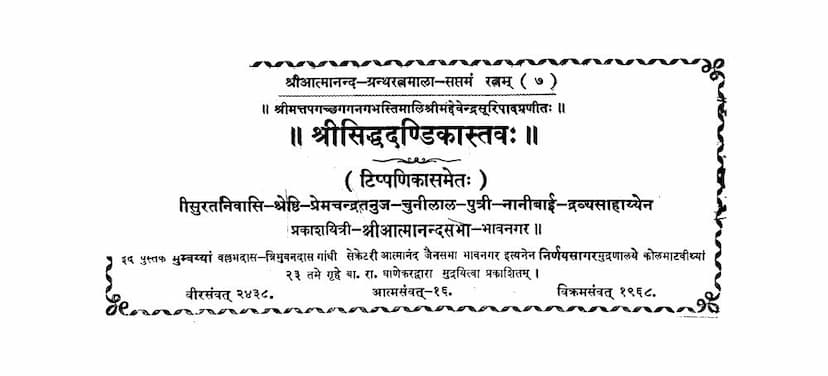Siddhadandikastav
Added to library: September 2, 2025

Summary
Here is a comprehensive summary in English of the Jain text "Siddhadandikastav" by Atmanand Sabha, based on the provided catalog link and the text snippets:
Book Title: Siddhadandikastav (सिद्धदण्डिकास्तवः) Author: Shrimad Devendrasuri (श्रीमद्देवेन्द्रसूरि), a disciple of Shrimad Jagachandrasuri of the Brihadgachchha (later known as Tapgachchha). Publisher: Atmanand Sabha, Bhavnagar. Catalog Link: https://jainqq.org/explore/034184/1
Overall Purpose and Theme:
The "Siddhadandikastav" is a devotional hymn (stotra) that elaborates on the numbers and patterns of souls achieving liberation (Siddhi) and those residing in the highest heavens (Sarvartha) within Jain cosmology. It systematically details how these numbers can be calculated and understood through various numerical progressions and arrangements, referred to as "dandikas" (rods or sequences). The text aims to deepen the understanding and devotion of the reader by presenting the vastness and order within the spiritual journey of souls.
Key Content and Structure:
The text, with accompanying commentary (Tippanika), is presented as a work that clarifies the "knowable, to be avoided, and to be accepted" substances, a fundamental aspect of Jain philosophy. It focuses on the lineage of kings (like those from the Nabhivansha) who achieved liberation.
The core of the "Siddhadandikastav" is the explanation of various "Siddhadandikas" – structured numerical arrangements that illustrate the pathways to liberation. These "dandikas" are described and exemplified through numerical sequences:
-
Anuloma Siddhadandika (अनुलोमसिद्धदण्डिका): This section details sequences where numbers increase in a straightforward, progressive manner. It illustrates how fourteen lakhs (140,000) of kings achieved liberation, followed by one soul in Sarvartha, then another fourteen lakhs in liberation, and so on. This continues, with variations in the number of souls in Sarvartha (one, then two, then three, up to fifty) between groups of fourteen lakhs achieving liberation, until the numbers become innumerable.
-
Pratiloma Siddhadandika (प्रतिलोमसिद्धदण्डिका): This describes sequences where numbers might appear to decrease or follow a reverse order, yet still maintain a systematic progression. It mentions two lakhs of souls in liberation, followed by two lakhs in Sarvartha, and then continuing with increasing numbers like three lakhs, four lakhs, and so on, up to innumerable quantities, between those achieving liberation.
-
Sama-Sankhya Siddhadandika (समसंख्यसिद्धदण्डिका): This deals with even numbers, showing arrangements where two souls are in liberation, followed by two in Sarvartha, then perhaps three in liberation and four in Sarvartha, continuing with progressive even numbers until reaching an innumerable state.
-
Ekotara Siddhadandika (एकउत्तरसिद्धदण्डिका): This focuses on sequences where numbers increase by one in each step. It illustrates one soul in liberation, then two in Sarvartha, then three in liberation, four in Sarvartha, and so on, until the numbers become innumerable in both categories.
-
Vyuttara Siddhadandika (व्युत्तरसिद्धदण्डिका): This describes sequences where numbers increase by a fixed difference, like increasing by two (odd numbers). It shows one soul in liberation, then three in Sarvartha, then five in liberation, seven in Sarvartha, continuing with such progressions until the numbers become innumerable.
-
Vichitra Siddhadandika (विचित्रा सिद्धदण्डिका): This is the most complex section, detailing "unequal-increasing sequences" (Vishama-uttara). It involves intricate patterns and specific number sets (like 2, 5, 9, 13, 17, 22, etc.) that are added sequentially. The text explains how these numbers are placed and calculated, creating multi-layered sequences where the final number of one sequence becomes the starting point for the next, eventually leading to innumerable souls in both liberation and Sarvartha. This section emphasizes the detailed calculations and the cyclical nature of these numerical progressions. The text highlights that the last number of one sequence becomes the first number of the subsequent sequence.
Key Figures and Context:
- Author: Shrimad Devendrasuri, a prominent spiritual leader from the Tapgachchha tradition.
- Lineage: The text is associated with the lineage of kings (Nabhivansha) who achieved liberation.
- Sponsorship: The publication was made possible by the financial assistance of Nanibai, daughter of Chunilal and wife of Premchand, residents of Surat, facilitated by the Atmanand Sabha, Bhavnagar.
- Historical Context: The author, Shrimad Devendrasuri, is placed in the 13th century Vikram Samvat, as indicated by his passing in 1327 Vikram Samvat, as per the Guravali of Shrimad Munisundarsuri.
Significance and Purpose of the "Dandikas":
The "dandikas" are not merely abstract numerical exercises. They serve to:
- Illustrate the Immensity of Souls: By presenting these structured sequences, the text conveys the staggering number of souls that have attained various stages of spiritual perfection.
- Demonstrate Spiritual Order: The patterns and progressions highlight the underlying order and systematic nature of the spiritual journey in Jainism.
- Inspire Devotion: Understanding these numbers and the paths to liberation can foster deeper reverence and devotion among followers.
- Educational Tool: The text acts as an educational resource for monks and lay followers to comprehend complex cosmological and soteriological concepts.
Conclusion:
The "Siddhadandikastav" is a profound Jain text that meticulously details the calculations and patterns of liberated souls and those in the highest heavens. Through its various "dandikas," it aims to provide a comprehensive understanding of spiritual attainments within the framework of Jain cosmology, inspiring devotion and intellectual engagement with these sacred concepts. The text is a testament to the detailed astronomical and spiritual calculations prevalent in Jain tradition, presented in a devotional and instructive manner.